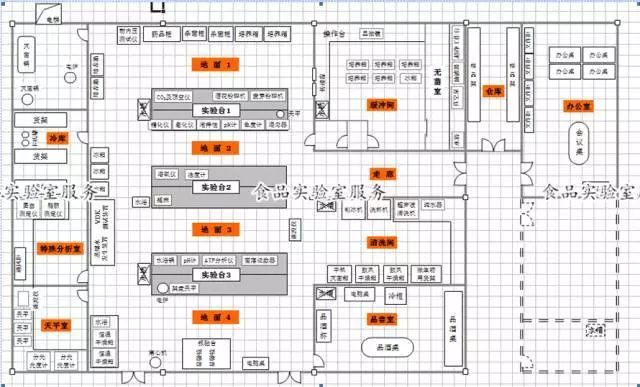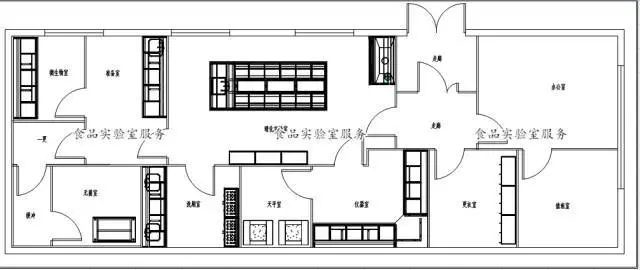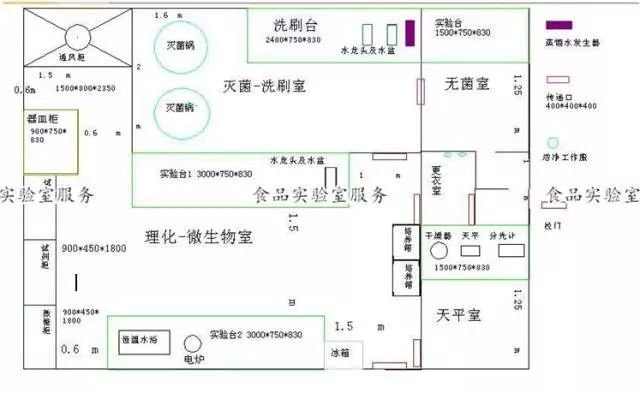"People-oriented, people and the environment" has become a topic of great concern to people. In the "safe, environmentally friendly, practical, durable, beautiful, economic, excellence, leading", the planning and design concept.
Laboratory design requirements
According to the needs of the test mission, the laboratory has valuable precision instruments and various chemicals, including flammable and corrosive drugs. In addition, harmful gases or vapors are often produced during operation. Therefore, there are special requirements for the laboratory structure, environment, indoor facilities, etc., which should be considered when preparing a new laboratory or remodeling the original laboratory.
Laboratory rooms are roughly divided into three categories: precision instrument laboratories, chemical analysis laboratories, and auxiliary rooms (offices, storage rooms, steel cylinder rooms, etc.). The laboratory is required to be kept away from dust, smoke, noise and vibration sources. Therefore, the laboratory should not be built near traffic routes, boiler rooms, machine rooms and production workshops (except workshop laboratories). In order to maintain good weather conditions, it should generally be north-south.
1. Precision instrument room
The precision instrument room is required to have the functions of fireproof, shockproof, anti-electromagnetic interference, anti-noise, moisture-proof, anti-corrosion, dust-proof and anti-harmful gas intrusion. The room temperature is kept as constant as possible. In order to maintain the good performance of the general instrument, the temperature should be 15~30 °C, and the condition is best controlled at 18~25 °C. The humidity is between 60% and 70%. The instrument room with constant temperature can be equipped with double doors and windows and air conditioning.
The instrument room can be terrazzo or anti-static floor. It is not recommended to use carpet. Because the carpet is easy to accumulate dust, it will also generate static electricity. The power supply voltage of large precision instrument room should be stable. Generally, the voltage fluctuation range is ±10%. If necessary, equip with ancillary equipment (eg, regulated power supply, etc.). In order to ensure uninterrupted power supply, dual power supply can be used. A dedicated ground wire should be designed with a grounding resistance of less than 4 ohms.
In the gas chromatograph chamber and the atomic absorption analysis chamber, high pressure steel cylinders are used, preferably in the vicinity of the steel cylinder chamber (direction north). The distance between the test bench and the wall for the instrument is 500mm, which is convenient for operation and maintenance. There is good ventilation in the room, and a partial exhaust hood is arranged above the atomic absorption instrument.
Microcomputers and microcomputer-controlled precision instruments have certain requirements on the supply voltage and frequency. In order to prevent voltage transients, instantaneous power failure, and insufficient voltage, etc., the uninterruptible power supply (UPS) can be selected as needed.
While designing a dedicated instrument analysis room, the corresponding chemical processing room is designed nearby, which is necessary to protect the instrument and strengthen management.
2. Chemical Analysis Room
In the chemical analysis room, the chemical treatment and analytical determination of the sample are carried out. Some small electrical equipment and various chemical reagents are often used in the work. If the operation is inadvertent and dangerous, the design of the chemical analysis room should be designed according to these characteristics. Note the following requirements:
(1) Building requirements: The building of the laboratory shall be constructed of fire-resistant or non-combustible materials, and the fireproof performance shall also be considered for partitions and ceilings. The terrazzo floor can be used, the window should be dustproof, the indoor lighting should be good, the door should be opened outwards, and the large laboratory should have two exits to facilitate the evacuation of personnel in the event of an accident.
(2) Water supply and drainage: The water supply must ensure the necessary water pressure, water quality, and water quantity to meet the needs of normal operation of the equipment. The indoor general valve should be located in a position that is easy to operate, and the sewer should be made of acid and alkali resistant materials. There should be a floor drain on the ground.
(3) Ventilation facilities: Because toxic or flammable gases are often generated during laboratory work, the laboratory should have good ventilation conditions. There are generally three types of ventilation facilities:
1 Whole room ventilation: using exhaust fan or ventilation shaft, the number of air changes is generally 5 times / hour.
2 Partial exhaust hood: generally installed above the harmful gas part of large instruments. Above the harmful gases generated in the laboratory, a local exhaust hood is provided to reduce indoor air pollution.
3 fume hood: This is a local exhaust device commonly used in laboratories. There are heating sources, water sources, lighting and other devices inside. The fume hood can be made of fire-proof and explosion-proof metal material, and the anti-corrosion coating is applied inside, and the ventilation pipe should be resistant to acid and alkali gas corrosion. The fan can be installed in the top floor room and should have vibration and noise reduction. The exhaust pipe should be more than 2m above the roof. It is better to connect one exhaust fan to one fume hood. The sharing of one fan and ventilation pipe in different rooms is prone to cross-contamination. The correct position of the fume hood in the room is placed in a place where the air flow is small, or a better slit fume hood is used. The height of the ventilated countertop is 800mm, the width is 750mm, the net height in the cabinet is 1200-1500mm, the height of the operating port is 800mm, and the length of the cabinet is 1200-1800mm. The wind speed at the seam is 0.3-0.5m/s and the opening height of the window is 300-500mm. The width of the rear air passage of the baffle is equal to more than 2 times the width of the slit.
(4) Gas and power supply: Conditional laboratories can install pipeline gas. The power of the laboratory is divided into electricity for lighting and equipment. Lighting is best done with fluorescent lights. In the electricity consumption of the equipment, the electrical appliances running 24h are separately powered by the refrigerator, and the rest of the electrical equipment are controlled by the main switch. The electric heating equipment such as the oven and the high temperature furnace should have special sockets, switches and fuses. Install emergency lights indoors and in the hallway for use when there is a sudden power outage at night.
(5) Experimental platform: The experimental platform is mainly composed of a table top and a bracket under the table and a cabinet. For convenient operation, a medicine rack can be set on the table, and the water tank can be installed at both ends of the table.
The test bench is generally 750mm wide and can be 1500-3000mm depending on the size of the room, and the height can be 800-850mm. The countertop is usually made of veneer physicochemical board, solid core physicochemical board, anti-corrosion artificial stone or terrazzo prefabricated board. The ideal countertop should be flat, not easy to break, resistant to acid and alkali and solvent corrosion, heat resistant, not easy to break glassware.
3. Auxiliary room
(1) Drug storage room: Since many chemical reagents are flammable, explosive, toxic or corrosive, do not purchase too much. The storage room is only used to store a small amount of chemicals to be used in the near future, and to meet the safety requirements for the storage of dangerous goods. It must have the function of preventing open flame, moisture, high temperature, direct sunlight, and lightning protection. The room of the drug storage room should be facing north, dry and well ventilated. The ceiling should be shaded and insulated, the doors and windows should be strong, the windows should be high windows, and the doors and windows should be equipped with sun visors. The door should open outwards. The room temperature of the flammable liquid storage room is generally not allowed to exceed 28 °C, and the explosives must not exceed 30 °C. A small number of dangerous goods can be classified and stored. The indoor exhaust cooling fan is equipped with explosion-proof lighting. Fire equipment is available. A semi-basement that meets the above conditions can be used as a drug storage room.
(2) Cylinder room: The flammable or combustion-supporting cylinders are required to be placed in the outdoor cylinder room. The cylinder room is required to be away from heat sources, fire sources and combustibles. The cylinder chamber should be constructed of non-combustible or flame-retardant materials, the wall with an explosion-proof wall, a lightweight top cover, and the door facing outward. Avoid sun exposure and good ventilation. The cylinder is more than 10m away from the open flame heat source, and the indoor is provided with an upright and stable iron frame for placing the cylinder.
Graphic design system
Graphic design We mainly consider the following factors:
1. Evacuation, evacuation, escape, smooth, unobstructed, safe passage; general laboratory doors are mainly opened inward, but if there is a room with explosion hazard, the door should be opened outwards, and the material of the door should be selected from pressure glass.
2. Human science (front and rear working space), the perfect coordination between the equipment and the operating space of scientific and technological workers reflects the scientific and humanized planning and design.
When doing graphic design, the first factor to consider is “safetyâ€. The laboratory is the most vulnerable place for explosions, fires, gas leaks, etc. When we are doing graphic design, we should try our best to keep the laboratory ventilated and the escape route is smooth. According to international ergonomic standards. We make the following divisions for reference: the experimental platform and the experimental channel channel division criteria (the channel spacing is denoted by L):
When L>500mm, one side can operate;
When L>800mm, one can sit and operate;
When L>1200mm, you can sit on one side and stand on the side.
When L>1500mm, you can sit on both sides, and you can pass in the middle;
When L>1800mm, you can sit on both sides, and you can pass the instrument in the middle.
The platform and instrument platform should not be too close to the wall, and 400mm from the wall is appropriate. In order to be easily evacuated when work is dangerous, the aisles between the test benches should all lead to the corridor. Another: the height of the laboratory building should be 3.7 meters - 4.0 meters, the net height should be 2.7 meters - 2.8 meters, the clean height, pressure gradient, constant temperature and humidity and other special requirements of the laboratory net height should be 2.5 meters - 2.7 meters (excluding suspended ceilings); the laboratory corridor should have a net width of 2.5 meters to 3.0 meters, and the common laboratory double door width should be 1.1 meters to 1.5 meters (asymmetrical opening doors), and the single door width should be 0.8 meters to 0.9 meters. Rice is suitable.
3. Professional discipline functions: Laboratories are usually classified according to physics, inorganic chemistry, organic synthetic chemistry, and biology. According to the laboratory content, use and scale, each has its own characteristics, mainly consists of chemical basic laboratory, instrument analysis laboratory, clean laboratory, electronic computer room, research room, auxiliary laboratory, service supply room and so on.
The basic laboratory of chemistry mainly conducts experiments such as capacity analysis, ion measurement, redox reduction, etc. The general design equipment includes: test bench and washing station; fume hood and pipeline repair well; test bench with reagent rack and auxiliary workbench, Need to consider the research space or computer desk located in the laboratory, medicine cabinets, utensil cabinets, equipment and equipment for landing installations, first-aid devices, etc.
The instrumental analysis laboratory is mainly equipped with various large-scale precision analytical instruments. At the same time, it also includes ordinary small analyzers. The general design equipment includes: instrument table, test bench, fume hood, sky platform, computer desk, gas cylinder cabinet, washing Table, utensil cabinet, medicine cabinet, first aid, universal exhaust hood, atomic absorption hood, etc. The requirements for various instrumental analysis laboratories are listed below for reference.
Various instrumentation analysis laboratory requirements:
Gas Chromatography Chamber: The analysis of liquid organic compounds and gaseous samples that are easily converted to a gaseous state without decomposition. The instrument equipment mainly includes gas chromatograph, computer control system and data processing system. It has high degree of automation and high-efficiency separation ability for organic compounds. The carrier gases used are mainly H2, N2, Ar, He, CO2 and so on. However, for high-boiling compounds, the separation of hard-to-volatile and thermally unstable compounds, ionic compounds, and polymers is ineffective. Local exhaust is required and direct sunlight is avoided on the instrument to avoid the existence of electric and magnetic fields that affect the normal operation of the circuit system. General design: instrument table (should be away from the wall for instrument maintenance), universal exhaust hood, computer desk (generally in the instrument) Side table, side table, washing station, reagent cabinet, etc.
Liquid chromatography analysis room: mainly in high-efficiency separation, separation of complex organic compounds to obtain pure compounds, quantitative analysis and qualitative analysis, instruments and equipment mainly include: high performance liquid chromatography, suitable for high boiling compounds, difficult to volatile compounds , heat labile compounds, ionic compounds, polymers, etc., to make up for the shortcomings of gas chromatography. Environmental and laboratory basic equipment design requirements are similar to gas chromatographic chambers.
Mass spectrometry chamber: It is mainly the qualitative analysis of pure organic matter to realize the determination of molecular weight, molecular formula and molecular structure of organic compounds. The sample can be gas, liquid or solid. The main equipments are mass spectrometer and gas-mass spectrometer. Mass spectrometer is an instrument that uses the principle of electromagnetism to separate the ions of a substance according to the mass-to-charge ratio of the base feature (ie, the ratio of mass m to charge e - m/e). The disadvantage is that the complex organic mixture The separation is powerless. The gas chromatography has high separation efficiency and simple quantitative analysis. Combined with the high sensitivity of the mass spectrometer and strong qualitative analysis ability, the two instruments are combined with gas-mass spectrometer. Can complement each other to improve the quality and efficiency of analysis. The mass spectrometer may have mercury vapor escaping, taking into account local exhaust.
Spectral analysis room: The chemical analysis is established in the field of analytical chemistry based on the physical characteristics of the material that absorbs and scatters light and the physical properties of the emitted light. The main instruments are atomic emission spectrometer, atomic absorption spectrometer, spectrophotometer, atomic fluorescence spectrometer, fluorescence spectrophotometer, X-ray fluorescence spectrometer, infrared spectrometer, inductively coupled plasma (LCP) spectrometer, Raman spectrometer and so on. The laboratory should be kept away from the chemical laboratory as much as possible to prevent acid, alkali, corrosive gases and other damage to the instrument, away from the radiation source.
Attachment: Laboratory design
Laboratory design drawing 1

Laboratory design diagram 2

Requirement 1: The precision instrument room requires one pipe and one ventilation pipe, and holes are required on the wall.
Requirement 2: Operation room (2) The air conditioning system requires full exhaust air, and other microbial clean room air conditioners may be return air systems.
Requirement 3: A door should be left in the cylinder chamber, leaving two holes in the wall.
Laboratory design diagram three

Laboratory design diagram four

1. Laboratory: 7m*5m=35 m2
2. Sterile room: 1.5m*3m=4.5 m2
3. Balance room: 1.5m*2m=3 m2
4. Sterilization - scrubbing room: 4m*2m=8 m2
5. Physical and chemical-microbiology room: 1.5m*5m+3m*4m=19.5 m2
Source: Modern Laboratory Equipment Network
Custom Procedure Pack Components
Pack Components,Medical Pack Components,Procedure Pack Component,Custom Procedure Pack Components
ShaoXing SurgeCare Medical Products Co., Ltd. , https://www.sxsurgecaremedical.com